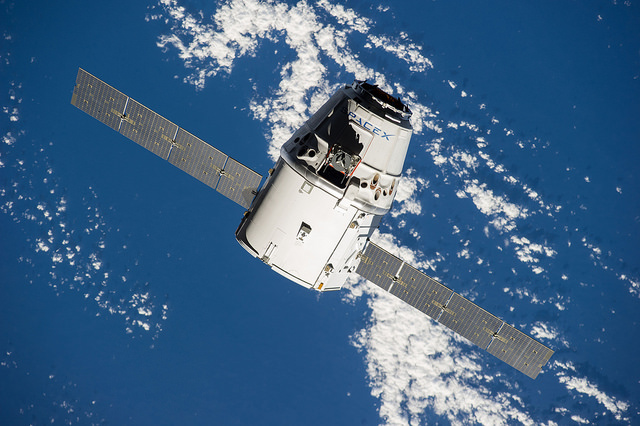
Almost three weeks later than originally planned, SpaceX—the Hawthorne, Calif.-based launch services company, headed by entrepreneur Elon Musk—is primed to launch its fifth dedicated Dragon cargo mission (CRS-5) under the language of the $1.6 billion Commercial Resupply Services contract with NASA. Liftoff of the two-stage Falcon 9 v1.1 booster is scheduled to occur from Space Launch Complex (SLC)-40 at Cape Canaveral Air Force Station, Fla., at 6:20:29 a.m. EST Tuesday, 6 January, which will produce a rendezvous and berthing of Dragon at the International Space Station (ISS) two days later. However, issues with orbital mechanics have forced SpaceX to pass over a backup launch opportunity on Wednesday, 7 January. If the vehicle does not get off the ground at its first attempt on Tuesday, it will try again no sooner than 5:09 a.m. EST Friday, 9 January. The CRS-5 mission will deliver upwards of 3,700 pounds (1,680 kg) of experiments, technology demonstrations, and supplies for the incumbent Expedition 42 crew and will remain berthed at the space station for about four weeks.
SpaceX first targeted the flight to occur before Christmas, tracking a 19 December launch, which would have marked the first occasion on which three Dragons had been despatched within a single calendar year. According to AmericaSpace’s Launch Tracker, the weather forecast anticipated a 70 percent probability of acceptable conditions on both the 19th and a backup date of the 20th, with a violation of the Thick Cloud Rule posing the only significant obstacle. Unfortunately, problems arose during the standard Static Fire Test of the nine Merlin 1D engines on the Falcon 9 v1.1’s first stage on 18 December. These are typically ignited for several seconds in the days preceding each mission, and the purpose is to ensure the proper functionality of the SLC-40 fueling hardware, as well as the satisfactory start-up and shutdown of the engines themselves.
However, as noted by AmericaSpace’s Mike Killian, the test ended prematurely and “an abundance of caution” caused SpaceX and NASA to pass on both launch opportunities and slip the CRS-5 mission into January. This provided engineers with sufficient time to review data from the test and commit to a new launch date. “While the recent Static Fire Test accomplished nearly all of our goals, the test did not run the full duration,” explained SpaceX in a statement. “The data suggests we could push forward without a second attempt, but out of an abundance of caution, we are opting to execute a second Static Fire Test prior to launch.” This second test was concluded, with no problems, on 19 December. As a result, a new launch date of 6 January was settled upon, with Range approval having also been secured for a backup attempt on the 7th, if needed. This would produce an arrival and berthing of Dragon at the ISS on 8-9 January.
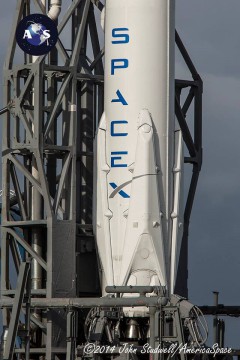
Caution, indeed, appeared to be the deciding factor, and a lengthy delay into the second week of the New Year was also necessary due to thermal and operational constraints—known as a “High Beta Angle”—which prohibited Dragon from being berthed at the ISS at any point between 28 December and 7 January. “The orbit of the ISS will be such that the angle between the [station’s] orbital plane and the Sun is high,” Mike Killian pointed out, “resulting in the ISS being in almost continuous sunlight for a ten-day period.” Sources at SpaceX told AmericaSpace that enough “small things” were seen during the first Static Fire Test to leave engineers and managers uncomfortable about pressing ahead with the launch until the data had been analyzed and everything possible done to assure mission success.
AmericaSpace understands that the success of the second Static Fire Test on 19 December, followed by four to five days of thorough data review, could have placed SpaceX in a posture to launch as early as 23 December. However, flying on busy holiday dates would have been unacceptable to the Federal Aviation Administration (FAA), and a launch on the 23rd would have also produced a berthing at the ISS on Christmas Day, which was not ideal from the standpoint of both the ISS Program and the SpaceX launch team. Moreover, the next available launch date was 26 December, which would also have required teams to be at their consoles and away from their families on Christmas Day. After the 26th, the impending High Beta Angle event made a launch impossible until 6 January.
The delay was a pity, for SpaceX’s achievements in 2014 had been remarkable. Although nearly four months have elapsed since the Cape last shook to the roar of the Falcon 9 v1.1’s engines, 2014 shaped up to be the company’s most successful year to date. First trialed in June 2010, the Falcon 9 achieved a flight rate of only two missions per annum through the end of 2012, before executing three launches in 2013. These included a Dragon cargo mission to the ISS in March, the maiden voyage of the uprated Falcon 9 v1.1 in September, and SpaceX’s first commercial geostationary payload, the SES-8 communications satellite, in December. The latter mission was covered by AmericaSpace’s imagery team in an expansive Photo Feature.
Having thus picked up the baton, SpaceX continued to run with it and triumphantly delivered a second geostationary satellite (Thaicom-6) into orbit in January 2014, followed by two more Dragon missions to the ISS in April and September. However, the Falcon 9 v1.1’s fortunes proved mixed during a frustrating summer, which saw its Orbcomm OG-2 mission delayed repeatedly, before a successful launch on 13 July. SpaceX also received some criticism from several areas of the media after initially announcing that it would not televise the launch. In the aftermath of the OG-2 flight, a “personal best” was established on 5 August, when another Falcon 9 v1.1 delivered the AsiaSat-8 communications satellite into geostationary transfer orbit, marking the first occasion on which SpaceX had flown twice in as little as three weeks. It also surpassed the company’s 2013 record by marking a fourth flight in a single calendar year. This latter achievement was itself broken on 7 September, when another Falcon 9 v1.1 delivered AsiaSat-6 into orbit … and again on 21 September, when the second Dragon cargo mission of 2014 roared perfectly into orbit.
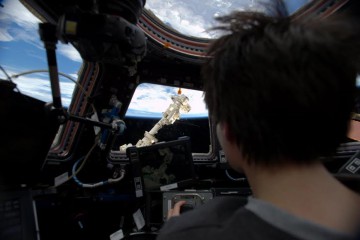
The CRS-5 mission is the fifth of 12 dedicated Dragon flights, executed under the language of SpaceX’s $1.6 billion Commercial Resupply Services (CRS) contract with NASA, signed back in December 2008. Under the provisions of this contract, the company is required to deliver a combined total of 44,000 pounds (20,000 kg) of equipment and supplies to the ISS. Dragon accomplished an initial Commercial Orbital Transportation Systems (COTS) test flight to the station in May 2012, before kicking off the first of its 12 dedicated missions (CRS-1) in October of the same year. Further missions followed in March 2013, April 2014, and September 2014.
Of course, SpaceX’s caution is understandable, particularly in light of the 28 October explosion of Orbital Sciences’ Antares booster and the catastrophic loss of the ORB-3 Cygnus cargo craft. Orbital is NASA’s second CRS partner and is required to deliver eight dedicated Cygnus missions to the ISS by 2016, under a $1.9 billion contract. The loss of ORB-3 was followed by a juggling of payloads and cargo priorities, and AmericaSpace understands that SpaceX initially offered Orbital a Falcon 9 v1.1 flight in the spring of 2016 to deliver a Cygnus mission. However, this option was not taken, partly because Orbital desired an earlier launch in December 2015. The Dulles, Va.-based company has since contracted with United Launch Alliance (ULA) for at least two Atlas V 401 flights in the fourth quarter of 2015 and in early 2016.
The success of the second Static Fire Test, and the resulting analysis of data, has thus placed SpaceX into position to support an “instantaneous” launch at 6:20:29 a.m. EST on Tuesday. Due to the nature of its destination—the ISS—the Falcon 9 v1.1 must launch precisely on time. Unlike several previous missions, there will be no margin to accommodate last-minute technical issues or poor weather conditions. If the vehicle cannot launch on time, Tuesday’s attempt will be scrubbed and the countdown clock recycled to support a second opportunity on Friday. Sources at SpaceX told AmericaSpace that the launch campaign has been refined to meet this tight launch “window” and that the aim is to roll the Falcon 9 v1.1 out to SLC-40 as close to launch as possible. Current plans anticipate the rollout to occur late Monday evening or very early Tuesday morning.
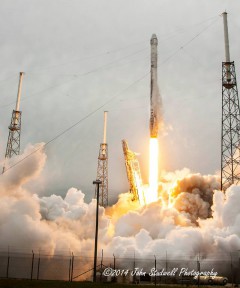
Assuming that NASA and SpaceX press ahead with the opening launch attempt—a decision which is expected to be finalized in a press briefing at the Kennedy Space Center (KSC) on Monday, 5 January—the Patrick Air Force Base weather forecast anticipates mostly cloudy conditions, with a 20 percent likelihood of rain, no lightning expected, and morning temperatures of 26 degrees Celsius (78 degrees Fahrenheit). Overall forecast is 60% favorable for a Jan. 6 liftoff.
After rollout to SLC-40, the Falcon 9 v1.1 will be fueled with liquid oxygen and a highly refined form of rocket-grade kerosene (known as “RP-1”). The cryogenic nature of the oxygen, whose liquid state exists within a temperature range from -221.54 degrees Celsius (-368.77 degrees Fahrenheit) to -182.96 degrees Celsius (-297.33 degrees Fahrenheit), requires the fuel lines of the engines to be chilled, in order to avoid thermally shocking or fracturing them. All propellants should be fully loaded within one hour and at 6:07 a.m. Tuesday, the countdown will reach its final “Go-No Go” polling point of all stations at T-13 minutes.
Passing through the polls at T-13 minutes, the Terminal Countdown will get underway at T-10 minutes. During this phase, the Merlin 1D engines will be chilled, preparatory to their ignition sequence. All external power utilities from the Ground Support Equipment (GSE) will be disconnected and at 6:15 a.m. the roughly 90-second process of retracting the “strongback” from the vehicle will get underway. The Flight Termination System (FTS), which is tasked with destroying the Falcon 9 v1.1 in the event of a major accident during ascent, will be placed onto internal power and armed.
By T-2 minutes and 15 seconds, the first stage’s propellant tanks will attain flight pressure. The Merlin 1D engines will be purged with gaseous nitrogen and, at T-60 seconds, the SLC-40 complex’s “Niagara” deluge system of 53 nozzles will be activated, flooding the pad surface and flame trench with 30,000 gallons (113,500 liters) of water, per minute, to suppress acoustic energy radiating from the engine exhausts. At T-3 seconds, the Merlins will roar to life, ramping up to a combined thrust of 1.3 million pounds (590,000 kg). Following computer-commanded health checks, the stack will be released from SLC-40 to begin the United States’ first space mission of 2015.
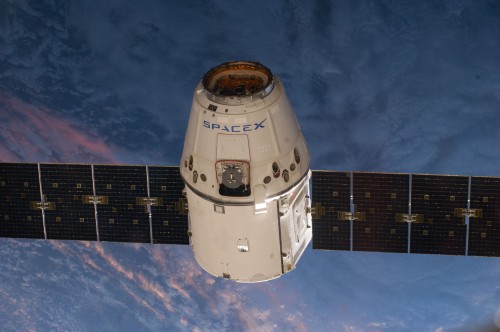
Immediately after clearing the tower, the booster will execute a combined pitch, roll, and yaw program maneuver, which is designed to establish it onto the proper flight azimuth to inject the CRS-5 Dragon spacecraft into low-Earth orbit. Eighty seconds into the climb uphill, the vehicle will exceed the speed of sound and experience a period of maximum aerodynamic duress—colloquially dubbed “Max Q”—on its airframe. At about this time, the Merlin 1D Vacuum engine of the second stage will undergo a chill-down protocol, ahead of its own ignition later in the ascent. At 6:22 a.m., 130 seconds after liftoff, two of the first-stage engines will throttle back, under computer command, in order to reduce the rate of acceleration at the point of Main Engine Cutoff (MECO).
Finally at T+2 minutes and 58 seconds, the seven remaining engines will shut down, and, a few seconds later, the first stage will separate from the rapidly ascending stack. The turn will then come for the restartable second stage, whose Merlin 1D Vacuum engine—with a maximum thrust of 180,000 pounds (81,600 kg)—will come to life to continue the boost into orbit. Based upon previous Dragon missions, it will burn for about six minutes and 45 seconds to inject the cargo ship into a “parking orbit.” During this time, the protective nose fairing, which covers Dragon’s berthing mechanism, will be jettisoned. Ten minutes after departing the Cape, the sixth overall ISS-bound Dragon will separate from the second stage and unfurl its two electricity-generating solar arrays, deploy its Guidance and Navigation Control (GNC) Bay Door to expose critical rendezvous sensors, and begin the intricate sequence of maneuvers to reach the ISS on Thursday, 8 January.
Another complicating factor is that Dragon must arrive at the ISS as quickly as possible, due to the presence of several science experiments which cannot survive for a long period in transit. In total, the CRS-5 payloads will support 256 separate investigations during the current Expedition 42 and the following increment, Expedition 43, which is expected to run under Terry Virts’ command from mid-March until mid-May 2015. One of these experiments will study planarian flatworms—which are capable of rebuilding body organs and nervous systems after damage—to better understand the process of wound healing in space. “Gravity, and the lack thereof, influences the way cells behave and their ability to rebuild tissue,” SpaceX explained in its CRS-5 press kit. “Studying planarians in space may reveal new aspects of how cells rebuild tissue, which could lead to breakthroughs in medical treatment for humans.”
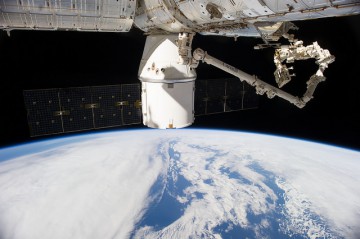
In charge of the successful arrival of CRS-5 at the space station are the Expedition 42 crew, commanded by NASA’s Barry “Butch” Wilmore, and also consisting of Russian cosmonauts Aleksandr Samokutyayev, Yelena Serova, and Anton Shkaplerov, U.S. astronaut Terry Virts, and Italy’s first woman in space, Samantha Cristoforetti. As part of preparations for Dragon, the crew will install the Centerline Berthing Camera System (CBCS) inside the Earth-facing (or “nadir”) hatch of the station’s Harmony node and route video equipment to permit imagery to be obtained by the Robotics Workstation (RWS) in the cupola and by Mission Control at the Johnson Space Center (JSC) in Houston, Texas. As with previous Dragons, CRS-5 will approach the ISS along the “R-Bar” (or “Earth Radius Vector”), which provides an imagery line from Earth’s center toward the station, effectively approaching its quarry from “below.”
In doing so, Dragon will take advantage of natural gravitational forces to provide braking for its final approach and reduce the overall number of thruster firings it needs to perform. By Thursday morning, it will reach the vicinity of the ISS. A carefully orchestrated symphony of maneuvers will then bring the cargo ship to a “Hold Point” about 1.5 miles (2.4 km) from the space station, whereupon it must pass a “Go-No Go” poll of flight controllers in order to draw closer. Further polls and holds will be made at distances of 3,700 feet (1,130 meters) and 820 feet (250 meters), after which Dragon will creep toward its target at less than 3 inches (7.6 cm) per second.
Critically, at 650 feet (200 meters), it will enter the “Keep-Out Sphere” (KOS), which provides a collision avoidance exclusion zone, and its rate of closure will be slowed yet further to just under 2 inches (5 cm) per second. After clearance has been granted for the robotic visitor to advance to the 30-foot (10-meter) “Capture Point,” the final stage of the rendezvous will get underway, bringing Dragon within range of the 57.7-foot-long (17.6-meter) Canadarm2 mechanical arm. Wilmore will be at the controls for the capture and berthing, with Cristoforetti backing him up. Both astronauts will be stationed within the multi-windowed cupola. Following the initial capture of Dragon—an event anticipated to take place at about 6 a.m. EST Sunday—it will be maneuvered to its berthing interface on the nadir port of the Harmony node.
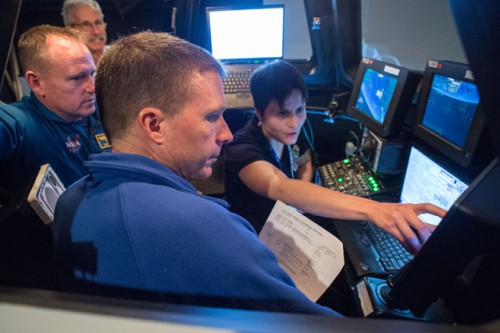
Physical berthing will occur in two stages, with Wilmore’s crew overseeing “First Stage Capture,” in which hooks from the node’s nadir Common Berthing Mechanism (CBM) will extend to snare the cargo ship and pull their respective CBMs into a tight mechanized embrace. “Second Stage Capture” will then rigidize the two connected vehicles, by driving 16 bolts, effectively establishing Dragon as part of the ISS for the next four weeks. Shortly afterwards, the Expedition 42 crew will be given a “Go” to pressurize the vestibule leading from the Harmony nadir hatch into the cargo ship.
Laden with more than 3,700 pounds (1,680 kg) of experiments, technology demonstrations, and supplies, the CRS-5 Dragon will support much of the scientific research to be undertaken during Expedition 42. One key payload is NASA’s Cloud Aerosol Transport System (CATS), to be installed on the Exposed Facility (EF) of Japan’s Kibo laboratory module. This instrument will spend between six months and three years measuring the location, composition and distribution of pollution, dust, smokes, aerosols, and other particulates in the atmosphere, using Light Detection and Ranging (LIDAR).
Operating at three wavelength bands—at 1,064, 532 and 355 nanometers—the data from CATS will be utilized to explore the properties of cloud and aerosol layers, as well as helping to develop and refine climate models and provide insights for future observations of Mars, Jupiter and other planetary bodies. In readiness for launch, CATS departed NASA’s Goddard Space Flight Center (GSFC) in Greenbelt, Md., on 30 September, bound for SpaceX’s facility at Cape Canaveral, for final pre-launch processing. It was installed aboard the unpressurized “Trunk” of the Dragon vehicle on 8 October. In addition to CATS, the CRS-5 mission also carries an IMAX camera for filming during four upcoming ISS increments, together with tools to be used during a series of U.S. spacewalks to support the arrival of two International Docking Adapters (IDAs) in June and December.
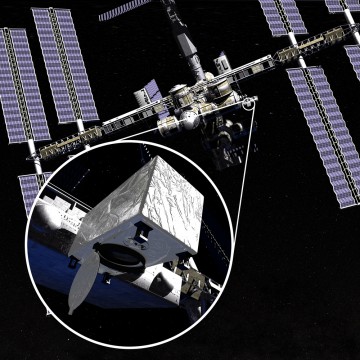
Image Credit: NASA
Present plans envisage the CRS-5 Dragon remaining berthed at the ISS for about four weeks, with its robotic unberthing, departure and return to Earth anticipated in early February. It will be loaded with supplies, hardware, and computer equipment, as well as experiment results, which it will transport back through the atmosphere to a parachute-assisted splashdown off the coast of Baja California. At present, Dragon is the only unpiloted cargo craft capable of returning safely to Earth; by contrast, its partners—Europe’s Automated Transfer Vehicle (ATV), Japan’s H-II Transfer Vehicle (HTV), Russia’s Progress, and Orbital Sciences’ Cygnus—are loaded with trash and intentionally incinerated in the dense upper atmosphere.
The CRS-5 mission marks the start of an astonishingly ambitious salvo of up to five Dragon launches to the ISS in 2015. As described in a recent AmericaSpace article, SpaceX will launch a pair of International Docking Adapters (IDAs) aboard the CRS-7 and CRS-9 missions in June and December respectively. These adapters will be installed by a combination of robotics and multiple EVAs onto two of the station’s Pressurized Mating Adapters (PMA-2 and PMA-3), thereby converting the shuttle-era Androgynous Peripheral Attach System (APAS)-95 interface into Boeing’s new Soft Impact Mating and Attenuation Concept (SIMAC) for Commercial Crew needs.
In addition to the delivery of the IDAs, SpaceX’s CRS-6 Dragon mission in April is expected to deliver the Cosmic Ray Energetics and Mass (CREAM) cosmic-ray-detection payload, whilst the CRS-8 flight in September will bring the inflatable Bigelow Expandable Activity Module (BEAM) to the ISS. Furthermore, the CRS-5 mission is expected to mark the first attempt by SpaceX to land the Falcon 9 v1.1’s first stage on a floating platform in the Atlantic Ocean. Known as the Autonomous Spaceport Drone Ship (ASDS), this vast barge will be the subject of another AmericaSpace article tomorrow (Sunday).
Want to keep up-to-date with all things space? Be sure to “Like” AmericaSpace on Facebook and follow us on Twitter: @AmericaSpace
Missions » ISS » COTS » CRS-5 »



Good luck SpaceX. Make history!
./
who says America is through with history in space. with the next chapter, the spacex we still lead the world in exploration.